Page 13 of 460
1. Front view camera (if so equipped)(P. 4-11)
2. Engine hood (P. 3-22)
3. Wiper and washer switch (P. 2-34)
4. Windshield (P. 8-18)
5. Power windows (P. 2-57)
6. Door locks (P. 3-5) NISSAN Intelligent Key® (P. 3-7)
Keys (P. 3-2)
7. Mirrors (P. 3-36) Side view camera (if so equipped)
(P. 4-11)
8. Tire pressure (P. 8-29) Flat tire (P. 6-3)
Tire chains (P. 8-29)
9. Fog light switch (if so equipped)
(P. 2-37)
10. Replacing bulbs (P. 8-25) Headlight and turn signal switch
(P. 2-37)
Daytime Running Lights (DRL)
system (P. 2-37)
Refer to the page number indicated in
parentheses for operating details.
LII2371
EXTERIOR FRONT
Illustrated table of contents0-3
Page 14 of 460
1. Rear wiper and washer switch(P. 2-34)
2. Lif tgate release (P. 3-22)
3. Rearview camera (P. 4-3)
4. Replacing bulbs (P. 8-25)
5. Fuel-filler door (P. 3-31) Fuel recommendation (P. 10-2)
Fuel-filler cap (P. 3-31)
6. Child safety rear door lock (P. 3-5)
Refer to the page number indicated in
parentheses for operating details.
LII2388
EXTERIOR REAR
0-4Illustrated table of contents
Page 19 of 460
Warninglight Name Page
or
Anti-lock Braking
System (ABS)
warning light 2-9
Automatic Emer-
gency Braking
(AEB) system
warning light2-9
or
Brake warning
light
2-9
Charge warning
light2-10
Engine oil pres-
sure warning light2-10
Low tire pressure
warning light2-10
Warning
light Name Page
Master warning
light 2-12
Power steering
warning light2-12
Seat belt warning
light and chime 2-13
Supplemental air
bag warning light2-13
Indicator
light Name Page
Front fog light in-
dicator light (if so
equipped) 2-13
Front passenger
air bag status
light2-14
High beam indi-
cator light (blue)
2-14
Indicator
light Name Page
Malfunction Indi-
cator Light (MIL) 2-14
Security indicator
light 2-15
Side light and
headlight indica-
tor light (green)2-15
Slip indicator light 2-15
Turn signal/
hazard indicator
lights2-15
Vehicle Dynamic
Control (VDC) OFF
indicator light2-15
WARNING AND INDICATOR LIGHTS
Illustrated table of contents0-9
Page 22 of 460
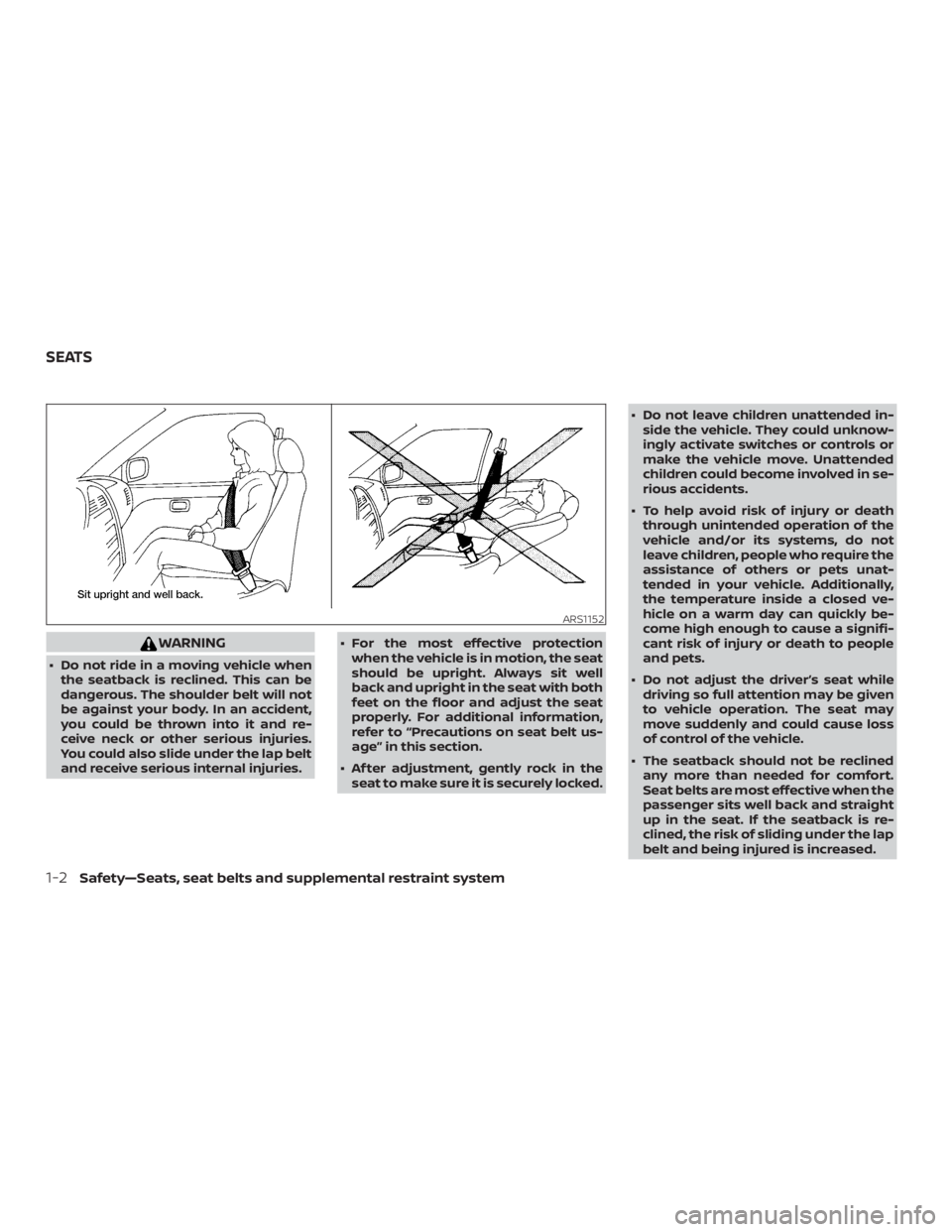
WARNING
∙ Do not ride in a moving vehicle whenthe seatback is reclined. This can be
dangerous. The shoulder belt will not
be against your body. In an accident,
you could be thrown into it and re-
ceive neck or other serious injuries.
You could also slide under the lap belt
and receive serious internal injuries. ∙ For the most effective protection
when the vehicle is in motion, the seat
should be upright. Always sit well
back and upright in the seat with both
feet on the floor and adjust the seat
properly. For additional information,
refer to “Precautions on seat belt us-
age” in this section.
∙ Af ter adjustment, gently rock in the seat to make sure it is securely locked. ∙ Do not leave children unattended in-
side the vehicle. They could unknow-
ingly activate switches or controls or
make the vehicle move. Unattended
children could become involved in se-
rious accidents.
∙ To help avoid risk of injury or death through unintended operation of the
vehicle and/or its systems, do not
leave children, people who require the
assistance of others or pets unat-
tended in your vehicle. Additionally,
the temperature inside a closed ve-
hicle on a warm day can quickly be-
come high enough to cause a signifi-
cant risk of injury or death to people
and pets.
∙ Do not adjust the driver’s seat while driving so full attention may be given
to vehicle operation. The seat may
move suddenly and could cause loss
of control of the vehicle.
∙ The seatback should not be reclined any more than needed for comfort.
Seat belts are most effective when the
passenger sits well back and straight
up in the seat. If the seatback is re-
clined, the risk of sliding under the lap
belt and being injured is increased.
ARS1152
SEATS
1-2Safety—Seats, seat belts and supplemental restraint system
Page 23 of 460
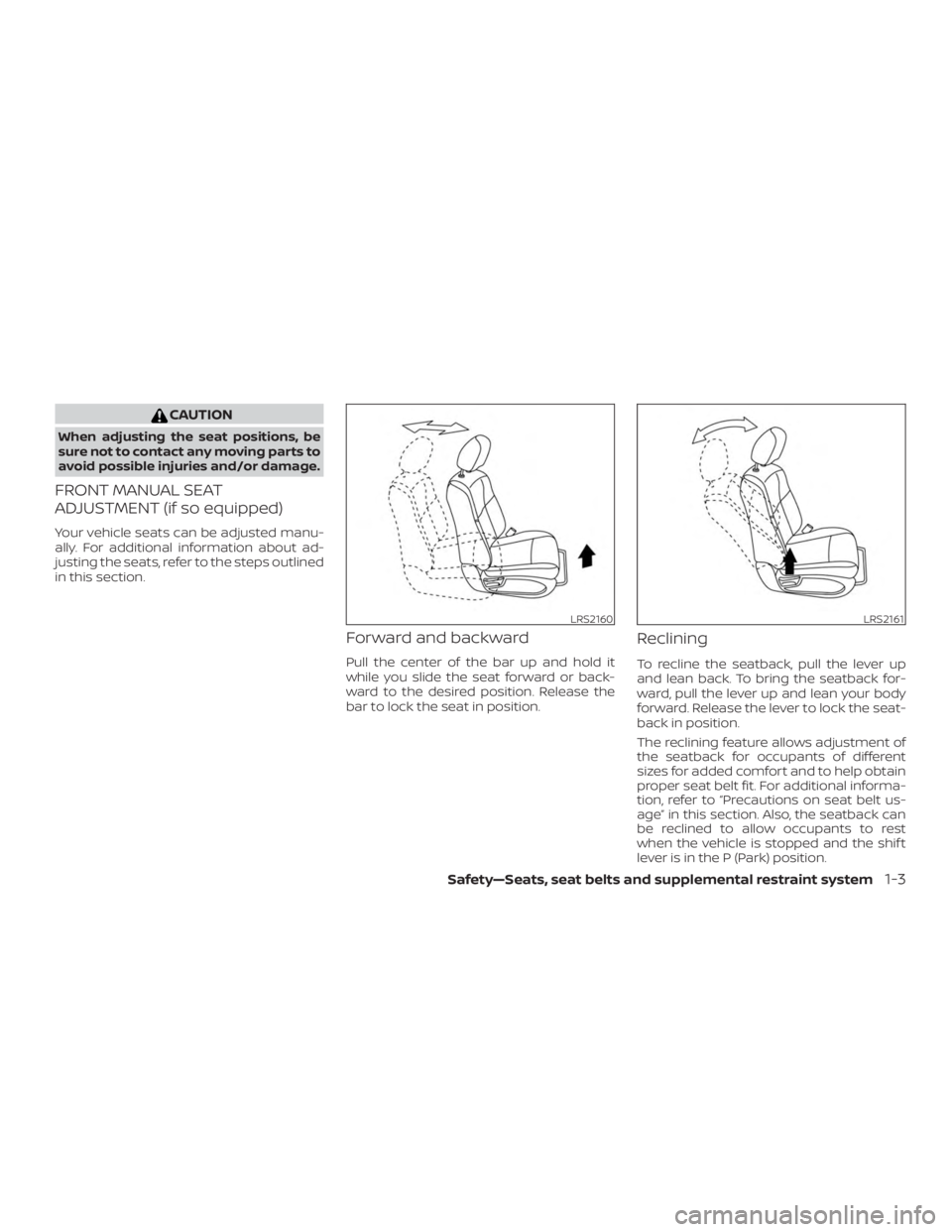
CAUTION
When adjusting the seat positions, be
sure not to contact any moving parts to
avoid possible injuries and/or damage.
FRONT MANUAL SEAT
ADJUSTMENT (if so equipped)
Your vehicle seats can be adjusted manu-
ally. For additional information about ad-
justing the seats, refer to the steps outlined
in this section.
Forward and backward
Pull the center of the bar up and hold it
while you slide the seat forward or back-
ward to the desired position. Release the
bar to lock the seat in position.
Reclining
To recline the seatback, pull the lever up
and lean back. To bring the seatback for-
ward, pull the lever up and lean your body
forward. Release the lever to lock the seat-
back in position.
The reclining feature allows adjustment of
the seatback for occupants of different
sizes for added comfort and to help obtain
proper seat belt fit. For additional informa-
tion, refer to “Precautions on seat belt us-
age” in this section. Also, the seatback can
be reclined to allow occupants to rest
when the vehicle is stopped and the shif t
lever is in the P (Park) position.
LRS2160LRS2161
Safety—Seats, seat belts and supplemental restraint system1-3
Page 26 of 460
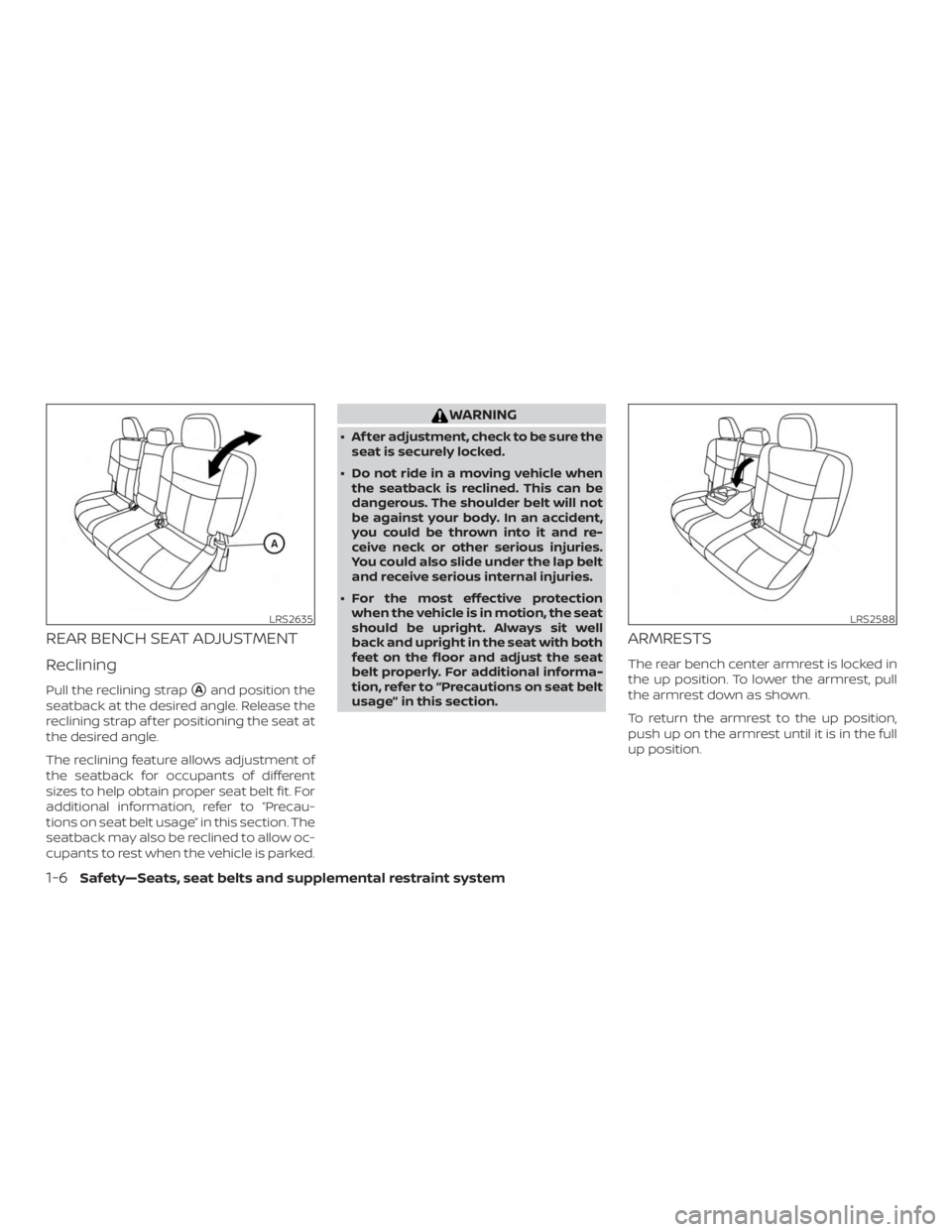
REAR BENCH SEAT ADJUSTMENT
Reclining
Pull the reclining strap�Aand position the
seatback at the desired angle. Release the
reclining strap af ter positioning the seat at
the desired angle.
The reclining feature allows adjustment of
the seatback for occupants of different
sizes to help obtain proper seat belt fit. For
additional information, refer to “Precau-
tions on seat belt usage” in this section. The
seatback may also be reclined to allow oc-
cupants to rest when the vehicle is parked.
WARNING
∙ Af ter adjustment, check to be sure the seat is securely locked.
∙ Do not ride in a moving vehicle when the seatback is reclined. This can be
dangerous. The shoulder belt will not
be against your body. In an accident,
you could be thrown into it and re-
ceive neck or other serious injuries.
You could also slide under the lap belt
and receive serious internal injuries.
∙ For the most effective protection when the vehicle is in motion, the seat
should be upright. Always sit well
back and upright in the seat with both
feet on the floor and adjust the seat
belt properly. For additional informa-
tion, refer to “Precautions on seat belt
usage” in this section.
ARMRESTS
The rear bench center armrest is locked in
the up position. To lower the armrest, pull
the armrest down as shown.
To return the armrest to the up position,
push up on the armrest until it is in the full
up position.
LRS2635LRS2588
1-6Safety—Seats, seat belts and supplemental restraint system
Page 27 of 460
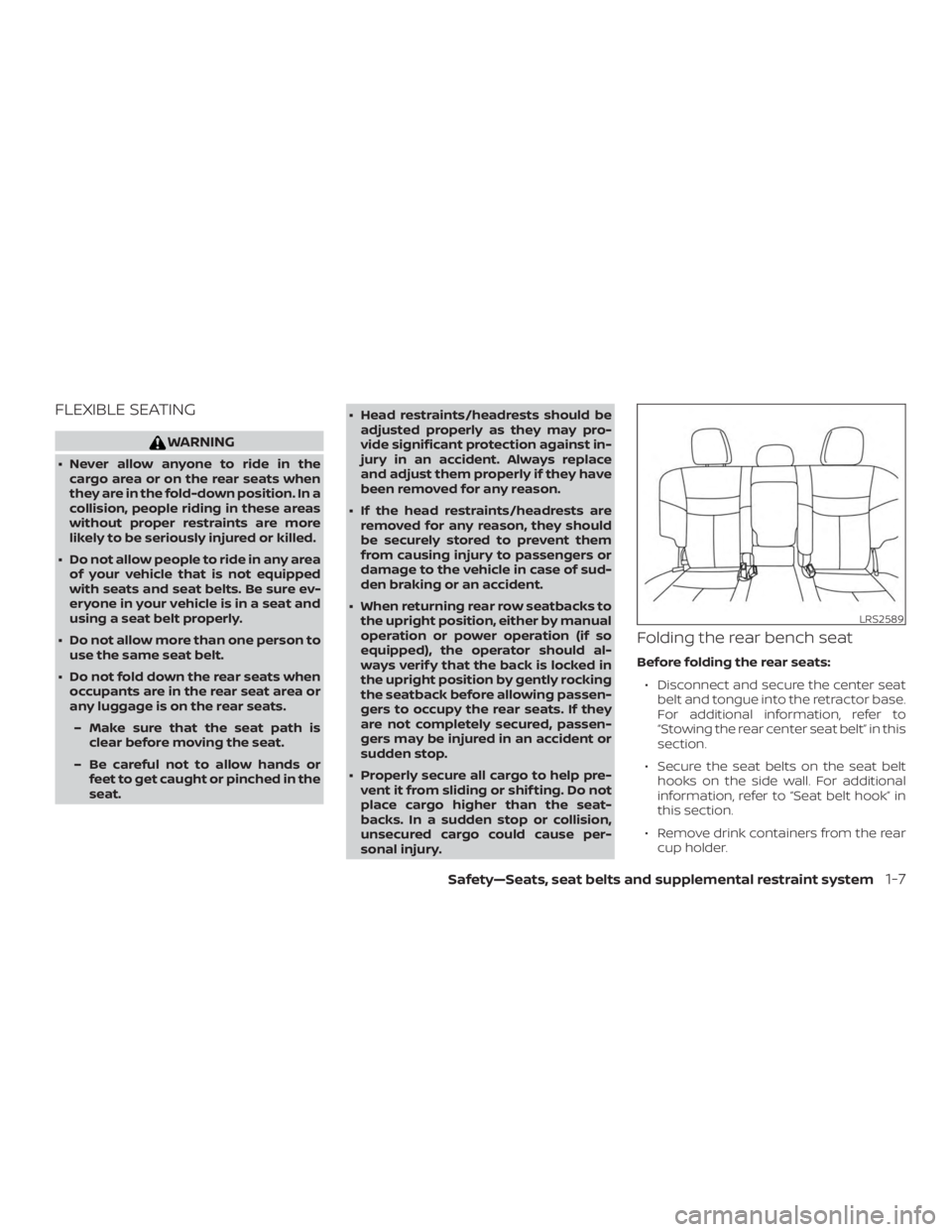
FLEXIBLE SEATING
WARNING
∙ Never allow anyone to ride in thecargo area or on the rear seats when
they are in the fold-down position. In a
collision, people riding in these areas
without proper restraints are more
likely to be seriously injured or killed.
∙ Do not allow people to ride in any area of your vehicle that is not equipped
with seats and seat belts. Be sure ev-
eryone in your vehicle is in a seat and
using a seat belt properly.
∙ Do not allow more than one person to use the same seat belt.
∙ Do not fold down the rear seats when occupants are in the rear seat area or
any luggage is on the rear seats.
– Make sure that the seat path is clear before moving the seat.
– Be careful not to allow hands or feet to get caught or pinched in the
seat. ∙ Head restraints/headrests should be
adjusted properly as they may pro-
vide significant protection against in-
jury in an accident. Always replace
and adjust them properly if they have
been removed for any reason.
∙ If the head restraints/headrests are removed for any reason, they should
be securely stored to prevent them
from causing injury to passengers or
damage to the vehicle in case of sud-
den braking or an accident.
∙ When returning rear row seatbacks to the upright position, either by manual
operation or power operation (if so
equipped), the operator should al-
ways verif y that the back is locked in
the upright position by gently rocking
the seatback before allowing passen-
gers to occupy the rear seats. If they
are not completely secured, passen-
gers may be injured in an accident or
sudden stop.
∙ Properly secure all cargo to help pre- vent it from sliding or shif ting. Do not
place cargo higher than the seat-
backs. In a sudden stop or collision,
unsecured cargo could cause per-
sonal injury.
Folding the rear bench seat
Before folding the rear seats:
∙ Disconnect and secure the center seat belt and tongue into the retractor base.
For additional information, refer to
“Stowing the rear center seat belt” in this
section.
∙ Secure the seat belts on the seat belt hooks on the side wall. For additional
information, refer to “Seat belt hook” in
this section.
∙ Remove drink containers from the rear cup holder.
LRS2589
Safety—Seats, seat belts and supplemental restraint system1-7
Page 30 of 460
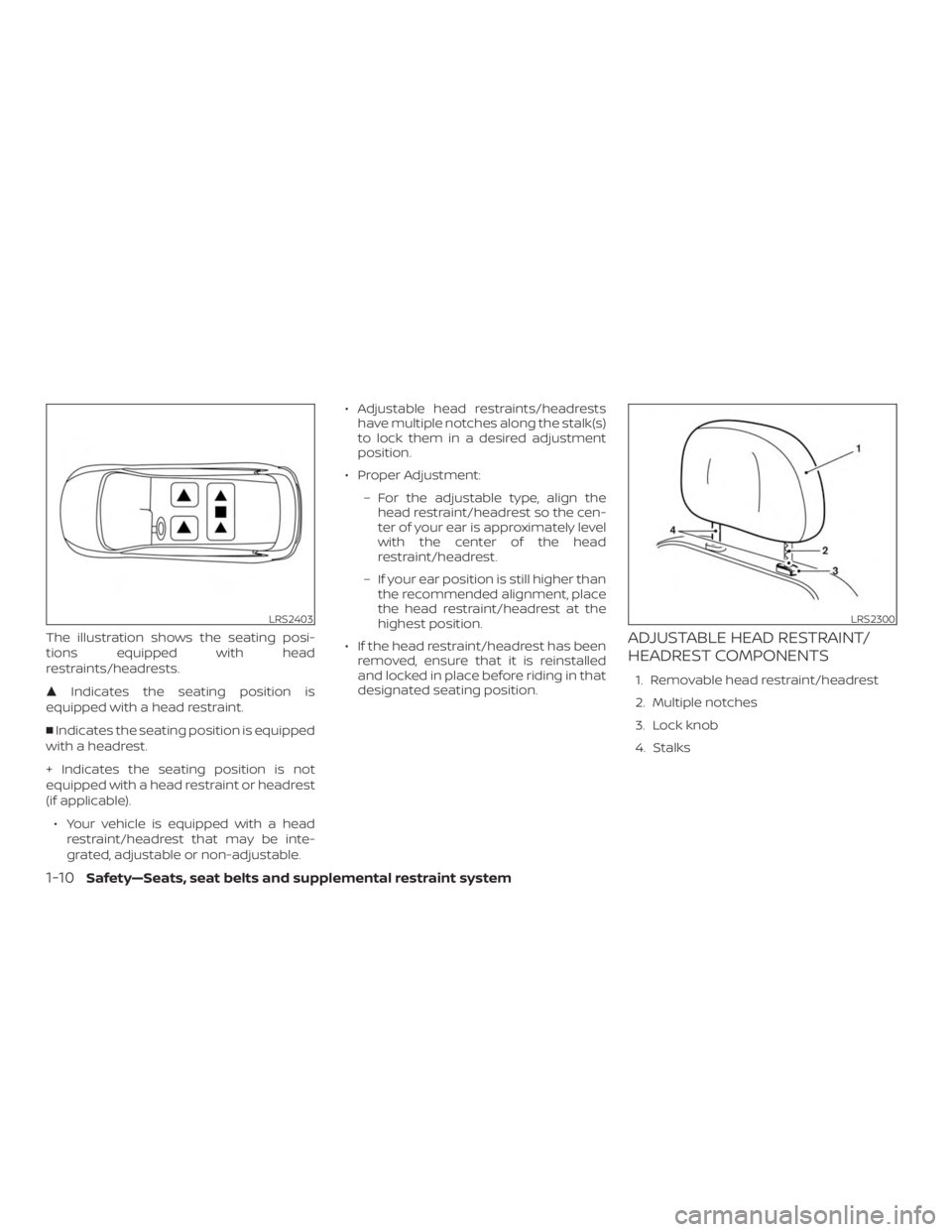
The illustration shows the seating posi-
tions equipped with head
restraints/headrests.
�Indicates the seating position is
equipped with a head restraint.
� Indicates the seating position is equipped
with a headrest.
+ Indicates the seating position is not
equipped with a head restraint or headrest
(if applicable).
∙ Your vehicle is equipped with a head restraint/headrest that may be inte-
grated, adjustable or non-adjustable. ∙ Adjustable head restraints/headrests
have multiple notches along the stalk(s)
to lock them in a desired adjustment
position.
∙ Proper Adjustment: – For the adjustable type, align thehead restraint/headrest so the cen-
ter of your ear is approximately level
with the center of the head
restraint/headrest.
– If your ear position is still higher than the recommended alignment, place
the head restraint/headrest at the
highest position.
∙ If the head restraint/headrest has been removed, ensure that it is reinstalled
and locked in place before riding in that
designated seating position.ADJUSTABLE HEAD RESTRAINT/
HEADREST COMPONENTS
1. Removable head restraint/headrest
2. Multiple notches
3. Lock knob
4. Stalks
LRS2403LRS2300
1-10Safety—Seats, seat belts and supplemental restraint system